
views
Taking Immediate Steps
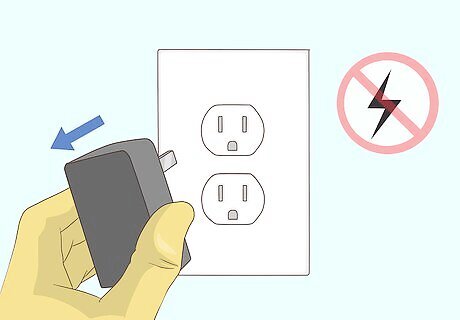
Assess the cause and severity of the burn. If the burn is from an electrical source, make sure the source is turned off or the person isn't connected to it anymore before helping. Similarly, try to protect yourself with gloves if the burn is caused by a chemical solution. When examining the blister, look for signs of a second-degree burn, which include very red skin, weeping from the area, blisters, pain, and even loss of skin. Symptoms of more serious third-degree burns include losing skin layers, dry and leathery skin, charred patches, painless areas where the skin is burned, and areas that look brown, black or white. Additionally, note the location of the burn, as well as its size. A large burn is often an emergency situation, so a person with a large burn likely needs medical attention.
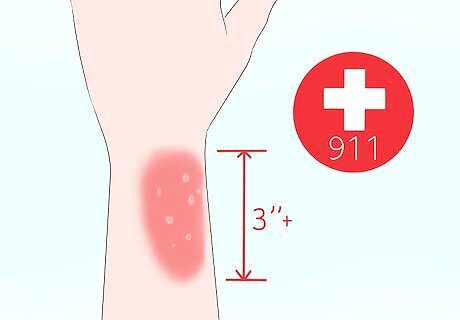
Call emergency services for large or serious burns. If the burn is covering more than 3 inches (7.6 cm), it's a good idea to call for medical assistance. Similarly, call for help if the person appears to be ill or otherwise affected by the burn. Also, if you're not sure whether it's a second-degree or third-degree burn, it's best to get medical help. It's best to see a medical provider for any burn, even if it's very small. However, you don't necessarily need to call for emergency help. Burns to the mouth and eyes caused by chemicals require medical attention no matter what.
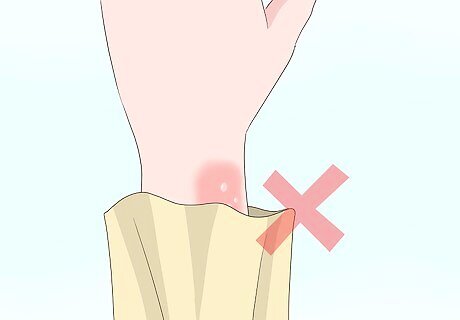
Take off any clothing covering the burn unless it's stuck to the skin. The clothing could retain heat against the skin, making the burn worse. Just take the clothing off, if possible. If not, cut that area of clothing off, pulling slowly. Don't try to remove clothing that seems to be stuck to the skin. Instead, cover up the burn with the clothing attached and seek medical attention. Keep in mind that clothing can quickly adhere to the burnt skin, and only a medical professional should try to remove it at that point. Doing it yourself could send the person into shock. If the burn is chemical, you should still remove the clothing, as long as it's not stuck to the skin. However, wait until you've flushed the area for a few minutes before doing so while still rinsing the area. Otherwise, you can drag chemicals across other areas of the body.
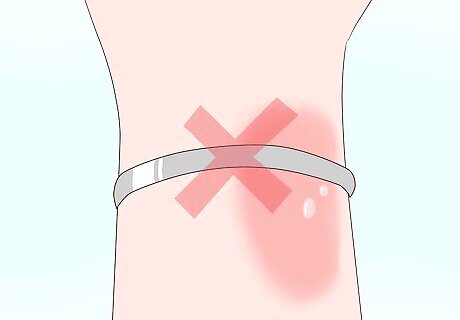
Take off any jewelry that may tighten around the area if it swells. Burns can cause swelling, making jewelry or even clothing like arm cuffs too tight on your skin. Take it off as quickly as you can to prevent it from getting stuck. For instance, if you have a ring on and you burn your finger, take the ring off.
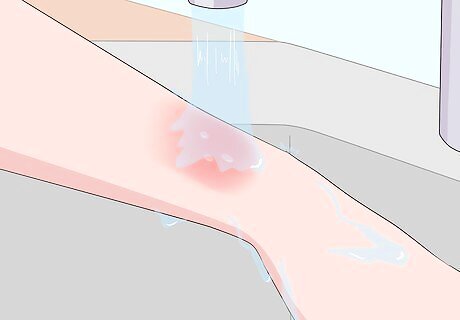
Place the burn under cool, running water immediately to cool it down. A burn can keep hurting your skin if you let it stay hot. Putting it in water cools down the skin, reducing the damage the burn can do. This step is also important if you have a chemical burn, as you want to wash the chemical off as quickly as possible. You can also use a tub of cool water if you prefer. However, don't use ice, as that can cause further damage. Hold it under the water for 15 to 30 minutes. If the burn is in a place that you can't easily put in water, you can apply a washcloth dipped in cool water instead. Don't submerge large areas of the body to treat a large burn, as that could cause hypothermia. However, you can spray the burn with a showerhead, if one is available. Place the person in the tub with their clothes still on, initially. Then, spray them with cool water from the shower.
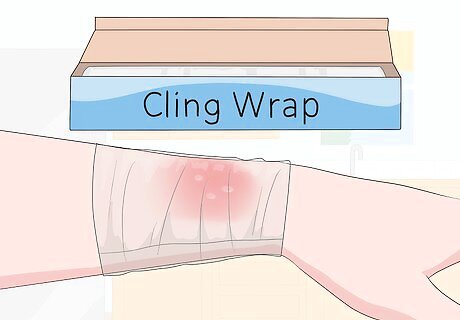
Wrap the burn in plastic cling wrap while on the way to a doctor. Loosely cover the burn with the cling wrap, which you don't need to secure since it sticks to itself. This will prevent the loss of fluids while the person waits for treatment. Additionally, the cling wrap won't stick to the person's skin, so it won't cause pain or shock when it's removed. This is the same type of plastic wrap you use in the kitchen.
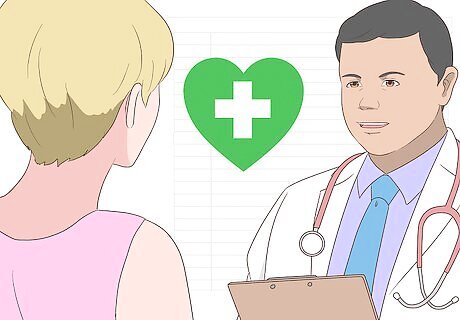
Talk to your doctor if you don't go to the emergency room. If you don't feel it is an emergency situation, you should still talk to your doctor about the burn. They may recommend you visit urgent care to make sure the blister doesn't need more care than you can provide at home. You can also try a virtual visit, which many medical systems offer now. You visit with a doctor using your smartphone or computer so they can view the blister.
Caring for the Burn
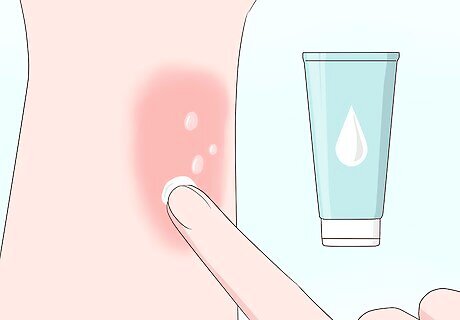
Apply lotion or aloe vera once the burn is cooled. Lotion will help make the burn feel better and promote healing. Plus, it keeps the wound moist, which is important for the healing process. Try to avoid the blistered area when applying lotion, as you don't want to break the blister. Apply lotion to areas around the blisters. Pick a lotion that has a moisturizer or aloe vera. You can also use pure aloe gel to relieve the burning sensation.
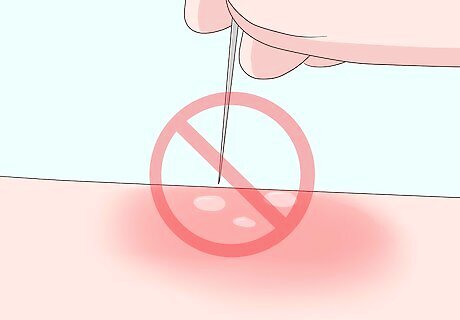
Avoid breaking blisters. The blister is there to protect the tissue underneath, as the liquid inside provides a cushion and cover for the damaged skin. It's best to let it break on its own, as when it breaks, it can leave an open wound behind. The open wound is more susceptible to infection than the blister. Be gentle when cleaning and bandaging this area, as too much pressure can break the blister. Since this is so difficult to do, your doctor may recommend soaking your burn, rather than trying to rub it clean. However, keep in mind that you should only bandage a burn wound if your medical provider advises you to do so. Bandages can stick to burn wounds, further damaging the skin and causing pain.
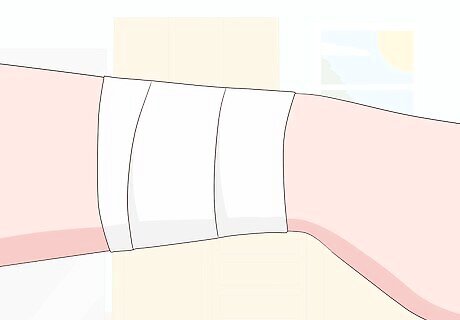
Cover the area with a bandage, particularly if the blister breaks. To cover a blister, place an adhesive bandage or sterile gauze gently over the wound. Make sure not to get adhesive on the burned area, as that will make it hurt worse. Choose a non-stick sterile gauze to minimize the risk of the bandage sticking to the wound. Similarly, get your wound checked by your doctor to see if you need an antibiotic lotion, which will both speed up healing and keep your bandages from sticking to your wound. Apply bandages loosely to avoid breaking the blister. If the blister isn't broken, you don't necessarily need to apply a bandage, particularly if there are no raw wounds. However, if the blister is likely to get dirty or will be rubbed by clothing, you should apply a bandage.
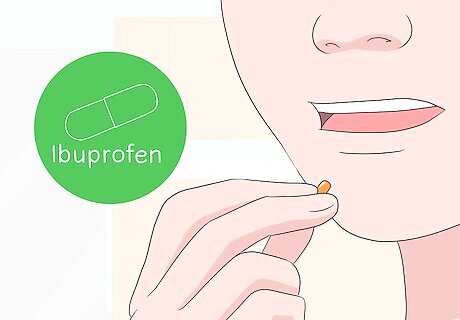
Take acetaminophen or ibuprofen for the pain. Over-the-counter pain medications can provide some relief from burn pain. Both acetaminophen and ibuprofen are safe for treating pain from burns. Follow the instructions on the back of the bottle for taking pain medication.
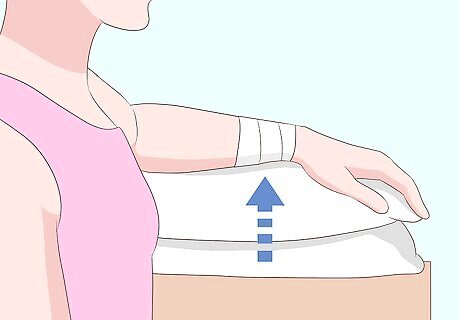
Lift the burned area to prevent swelling. If you can, keep the area elevated in the first couple of days. Elevating the area makes it more difficult for blood and liquid to pool there, reducing swelling. Try to keep the area above your heart when possible. You can use a pillow or a foot rest to prop up the limb.
Changing the Dressing
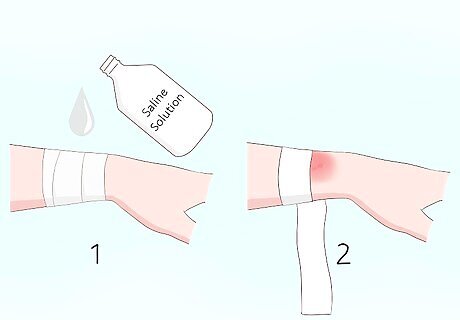
Peel off the dressing after soaking it in a saline solution. Soaking your bandages will loosen them so they come off of your skin more easily. This makes the process less painful and reduces the risk of infection. As another option, you can soak the bandage in water if you don't have saline solution. However, saline is a better option because it is sterile. Check with your doctor for advice specific to your burn treatment.
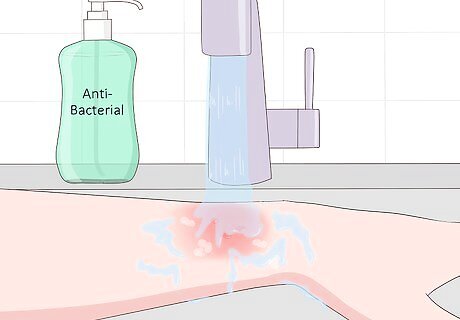
Wash the burn once a day with antimicrobial soap and warm water. Check with your doctor before cleaning your wound yourself. Then, gently rub the soap into the burned area and then rinse it off in cool water. Try to wash away any cream you've put on, as well as any dead skin. If the burn is on your face, wash it twice a day.
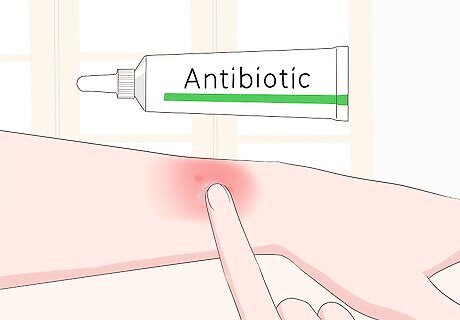
Apply an antibiotic ointment or cream recommended by your doctor. Once the blister has burst, you should treat it like an open wound, as it is one. Apply the cream to the gauze or bandage, then gently place it over the blister. Talk to your doctor about the best ointment for your burn.













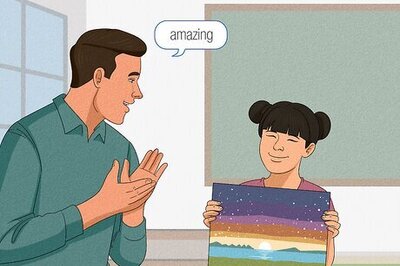



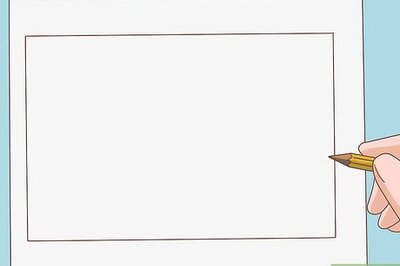
Comments
0 comment